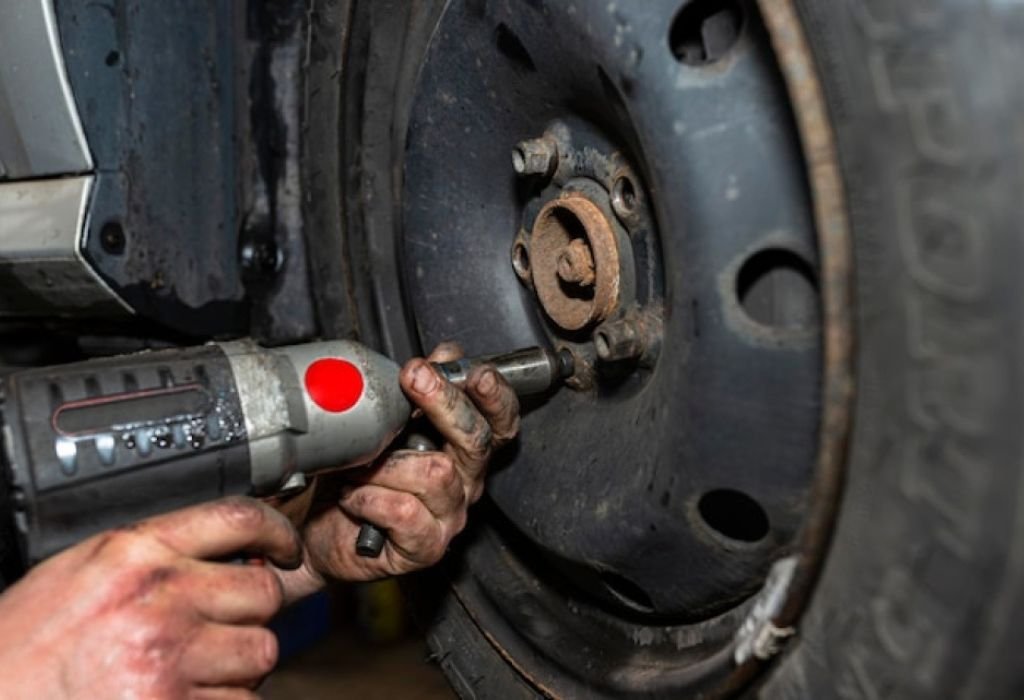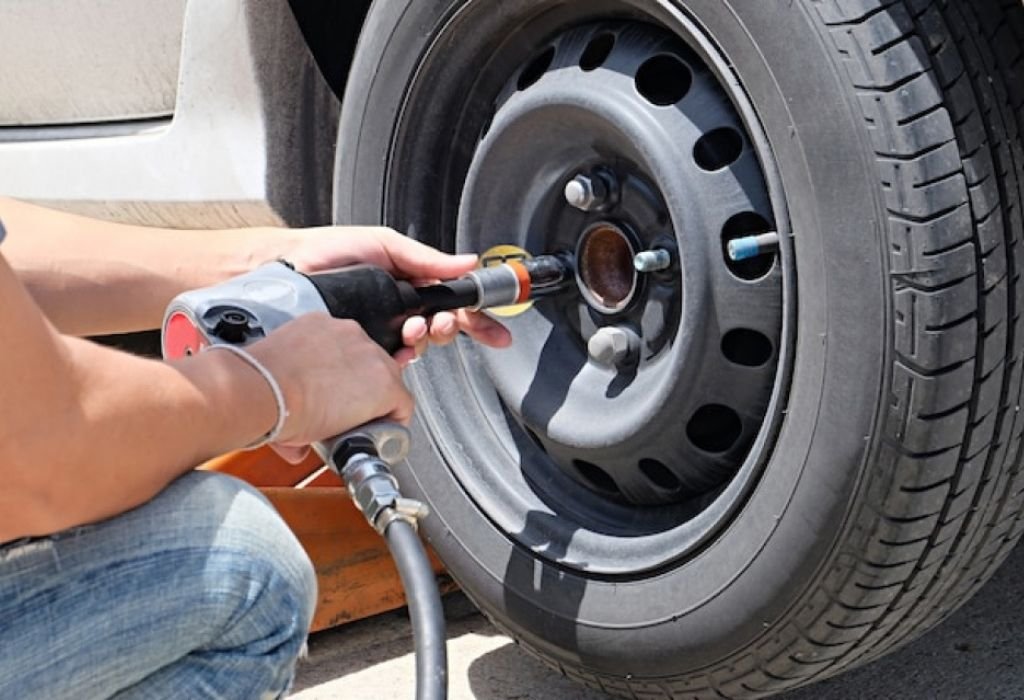You’re getting ready to change a flat tire and grab your impact driver. The question pops up: can you use an impact driver to remove wheel nuts?
Wheel nuts, also called lug nuts, are torqued tightly to secure the wheel in place. They often require significant force to loosen, especially if over-tightened or rusted.
An impact driver delivers rapid bursts of rotational force. This makes it excellent for driving screws into wood or metal.
However, wheel nuts are designed for much higher torque. They typically require 80–150 ft-lbs of force, depending on the vehicle.
Impact drivers are powerful but may fall short against such heavy torque requirements. In many cases, they simply don’t deliver enough strength.
That’s why mechanics rely on impact wrenches for wheel nuts. These tools are built for high torque and can handle stubborn fasteners with ease.
Still, some drivers wonder if their cordless impact driver could work in an emergency. With the right conditions, it may remove wheel nuts—but it’s not guaranteed.
According to automotive repair studies, improper tool use accounts for a high percentage of damaged wheel studs 【source】. Using the wrong tool can cause more problems than it solves.
This guide explores whether you can use an impact driver to remove wheel nuts, how it compares to an impact wrench, and what the safest approach is.
Understanding Wheel Nuts and Torque Requirements

Wheel nuts are designed to hold wheels securely to the hub. This prevents the wheel from loosening during driving.
Each nut is tightened to a specific torque specification. This ensures the wheel is both safe and balanced.
Passenger cars typically require 80–100 ft-lbs of torque. Larger trucks and SUVs often require 120–150 ft-lbs or more.
These torque levels are higher than what most impact drivers can consistently produce. Impact wrenches are built for this type of heavy-duty application.
If nuts are over-tightened at a shop, they may be even harder to remove. Rust and corrosion further increase the challenge.
The physics of torque show why correct tools matter. Without enough force, the nut won’t budge.
Understanding these requirements is essential before deciding whether to use an impact driver.
How tight are wheel nuts normally?
Most cars need 80–100 ft-lbs of torque.
Are trucks and SUVs higher?
Yes, often 120–150 ft-lbs.
Can rust make them harder?
Yes, rust increases resistance.
Why is torque important?
It ensures safe and balanced wheels.
What an Impact Driver Can and Cannot Do
Impact drivers excel at driving screws and bolts. Their concussive force makes them fast and efficient.
They are compact and lightweight. This makes them easy to carry for quick jobs.
Most impact drivers produce between 1,200 and 2,000 in-lbs of torque. This equals roughly 100–166 ft-lbs in theory.
However, that rating is peak torque, not sustained torque. Removing wheel nuts usually requires continuous high torque.
Impact drivers may work if the nuts are properly torqued and not rusted. In those cases, they might break the nuts free.
If nuts are over-tightened with an air gun, an impact driver likely won’t succeed. The tool may stall or strip sockets.
Impact drivers are not designed for automotive lug nuts. They are best for woodworking, metalworking, and construction tasks.
Knowing these limits prevents disappointment and tool damage.
How much torque does an impact driver make?
About 100–166 ft-lbs at peak.
Is that enough for wheel nuts?
Sometimes, but not always.
When will it work?
On properly torqued, rust-free nuts.
What if the nuts are too tight?
The impact driver may fail or stall.
Why Impact Wrenches Are Better for Wheel Nuts
Impact wrenches are built for high torque applications. They produce far more power than impact drivers.
Cordless impact wrenches often deliver 200–1,000 ft-lbs of torque. This is more than enough for wheel nuts.
Air-powered impact wrenches are even stronger. Professional mechanics use them for heavy-duty automotive work.
The design of an impact wrench supports larger sockets. This improves grip and reduces slippage on nuts.
Impact wrenches also apply torque more consistently. This prevents tool stalling and speeds up the job.
They are heavier than impact drivers but more durable. Their motors and gearboxes are designed for repeated high loads.
For anyone working with wheels regularly, an impact wrench is the safer choice. It prevents stripped sockets and wasted time.
This is why auto shops rely exclusively on impact wrenches.
How much torque do impact wrenches have?
200–1,000 ft-lbs, depending on model.
Is that more than impact drivers?
Yes, significantly more.
Do shops use impact drivers?
No, they use impact wrenches.
Why are they better for wheel nuts?
They provide consistent high torque.
Situations Where an Impact Driver Might Work
If wheel nuts are torqued correctly, an impact driver may loosen them. This usually means around 80–90 ft-lbs on smaller cars.
Cordless impact drivers with higher torque ratings have better chances. Some premium models push the limits of lug nut removal.
Using quality sockets helps maximize results. Cheap sockets may slip or break under strain.
If you recently installed the wheels yourself, the nuts may not be overtightened. In these cases, an impact driver might succeed.
Emergency roadside situations may justify trying. If it works, you save time and effort compared to using a hand wrench.
However, this is not reliable for all conditions. Rusty, corroded, or overtightened nuts likely won’t budge.
Impact drivers are best viewed as a backup. They are not a guaranteed tool for wheel nuts.
Use caution and avoid applying force that could damage the tool.
Can an impact driver work on small cars?
Yes, if torque is within range.
Do high-end models help?
Yes, they have more torque.
Will cheap sockets work?
No, always use quality sockets.
Is this reliable for emergencies?
Sometimes, but not guaranteed.
Risks of Using an Impact Driver on Wheel Nuts

Using the wrong tool can cause socket slippage. This damages both the nut and the tool.
Impact drivers may overheat under heavy load. Continuous attempts can shorten motor life.
The tool may not deliver enough torque. This leaves you stuck if nuts won’t loosen.
Overconfidence in the tool can cause mistakes. Wheel safety should never be compromised.
Damaged wheel studs can result from improper removal. Replacing studs is time-consuming and costly.
If sockets slip, injuries can occur. Flying tools or stripped nuts pose hazards.
Using impact drivers on lug nuts increases these risks. Always assess the condition before attempting.
Professional tools are safer for automotive work.
Can sockets slip on impact drivers?
Yes, increasing damage risk.
Do impact drivers overheat?
Yes, under heavy strain.
Can this damage studs?
Yes, improper removal harms threads.
Is it safe to rely on them?
Not for consistent wheel nut removal.
Better Alternatives for Removing Wheel Nuts
A lug wrench is the most basic tool. It provides leverage to loosen tight nuts.
Breaker bars are even more effective. Their long handles multiply torque with minimal effort.
Impact wrenches are the professional solution. Both cordless and pneumatic versions excel at wheel nuts.
Torque wrenches are best for reinstalling. They ensure nuts are tightened to proper specifications.
Carrying a cross wrench in your vehicle is smart. It combines portability with leverage for emergencies.
For those who do frequent tire work, invest in a cordless impact wrench. It saves time and ensures reliable results.
These tools are better suited for wheel nuts than impact drivers. Choosing the right one reduces frustration.
Relying on proper tools ensures both safety and efficiency.
What is the simplest tool for lug nuts?
A lug wrench.
What gives the most leverage?
A breaker bar.
What’s the best tool overall?
An impact wrench.
Do I need a torque wrench too?
Yes, for correct reinstallation.
Conclusion
Impact drivers are powerful tools, but they are not designed for wheel nuts. Their torque is limited compared to what lug nuts often require.
In some cases, they may work on properly torqued, rust-free nuts. However, this is not reliable for all vehicles or conditions.
Impact wrenches, breaker bars, and lug wrenches are much better choices. They provide the torque and safety required for secure wheel removal.
For anyone asking, “can I use impact driver to remove wheel nuts,” the answer is sometimes—but not as your main tool. The safest option is to use a tool built for the job.

I’m John F. Nicholas, the founder, lead writer, and drill enthusiast behind 101drill.com. With years of hands-on experience in power tools and DIY projects, I created this platform to share practical knowledge, expert tips, and real-world insights to help others master the art of drilling.
